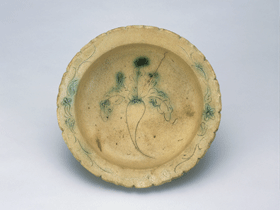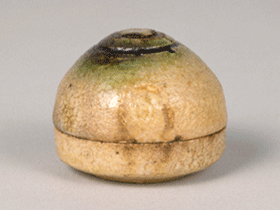美濃桃山陶
Momoyama-period Mino Ware
Back
黄瀬戸
Kiseto
Kiseto
黄瀬戸は、形状や緑のタンパン、輪花仕立てなど、その当時、日本にもたらされた中国の「華南三彩」などの影響を受けているとされます。釉薬の原料、陶土、窯、焚き方の違いで、安土桃山時代の黄瀬戸は釉調が美しく独特の趣をもっています。
なま乾きの時にヘラの先で模様を線刻し、花模様などの判を押しあて、タンパン(酸化銅)、褐彩(鉄)を施し、焼成します。
優れた伝世品は鉢や向付などの食器類が主で、肌がしっとりとした清楚な姿の宝珠香合や大根文輪花鉦鉢(重要文化財)は、代表的な名品です。桃山初期の黄瀬戸茶碗銘「朝比奈」は、明らかに茶碗として作られた貴重な優品です。これらの釉調や器肌は、通称「あぶらげ手」もしくは「あやめ手」と呼ばれ、古来茶人が珍重してきました。
なま乾きの時にヘラの先で模様を線刻し、花模様などの判を押しあて、タンパン(酸化銅)、褐彩(鉄)を施し、焼成します。
優れた伝世品は鉢や向付などの食器類が主で、肌がしっとりとした清楚な姿の宝珠香合や大根文輪花鉦鉢(重要文化財)は、代表的な名品です。桃山初期の黄瀬戸茶碗銘「朝比奈」は、明らかに茶碗として作られた貴重な優品です。これらの釉調や器肌は、通称「あぶらげ手」もしくは「あやめ手」と呼ばれ、古来茶人が珍重してきました。
The shape, green tanpan coloring, petaled forms, etc. of Kiseto ware are all said to have been influenced by the Kanan-sansai ware that arrived in Japan from China at around the time it was produced. Differences in the ingredients of the glazes, the clay, the kilns and the methods of firing resulted in the Kiseto produced during the Azuchi-Momoyama period (1573-1603) possessing a unique beauty.
After the clay had partially dried, a line design was carved or floral designs stamped into the surface before splashes of green tanpan (copper oxide) or brown (iron) glaze were applied and the work fired.
The majority of outstanding works that have survived to the present day are everyday tableware, such as bowls or mukōzuke dishes, etc., although there is also a jewel-shaped incense container with a graceful, neat form and a petaled bowl with a radish design (Important Cultural Property) that are representative of the style. The ‘Asahina’ tea bowl, that dates back to the early Momoyama period (1573-1603) was clearly made for drinking tea and is an outstanding and valuable work. The mixing of the glazes, combined with the textures of the clay, creates a finish known as Aburage-de (fried bean-curd) or Ayame-de (iris) and these works have been highly regarded by tea aficionados throughout history.
After the clay had partially dried, a line design was carved or floral designs stamped into the surface before splashes of green tanpan (copper oxide) or brown (iron) glaze were applied and the work fired.
The majority of outstanding works that have survived to the present day are everyday tableware, such as bowls or mukōzuke dishes, etc., although there is also a jewel-shaped incense container with a graceful, neat form and a petaled bowl with a radish design (Important Cultural Property) that are representative of the style. The ‘Asahina’ tea bowl, that dates back to the early Momoyama period (1573-1603) was clearly made for drinking tea and is an outstanding and valuable work. The mixing of the glazes, combined with the textures of the clay, creates a finish known as Aburage-de (fried bean-curd) or Ayame-de (iris) and these works have been highly regarded by tea aficionados throughout history.
 重要文化財 黄瀬戸大根文輪花鉦鉢
相国寺蔵
重要文化財 黄瀬戸大根文輪花鉦鉢
相国寺蔵
Kiseto Petaled Bowl with Radish Design. (Important Cultural Property) Shōkoku-ji
 黄瀬戸宝珠香合 根津美術館蔵
黄瀬戸宝珠香合 根津美術館蔵Jewel-Shaped Incense Container. Nezu Museum